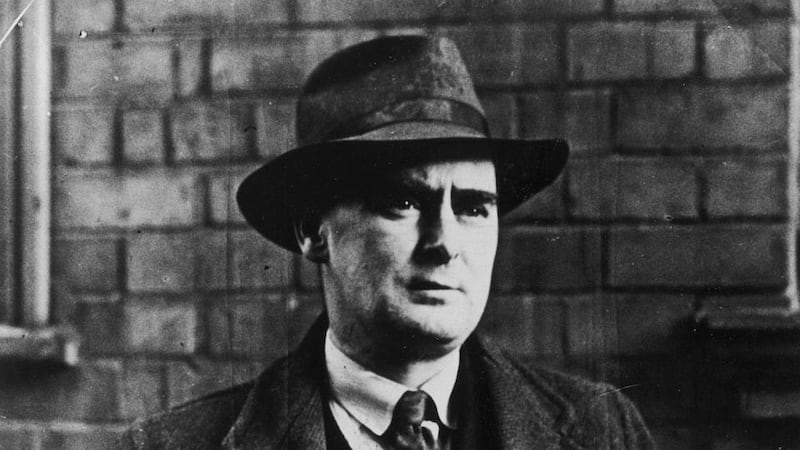Wandering around the vast Inchicore Railway Works during last weekend’s 175th anniversary open day, I was reminded of one of Myles na gCopaleen’s most brilliant creations, the demented “steam man”.
Obsessed with the mechanics of train travel, and assuming similar levels of interest in readers, he liked to begin his occasional dispatches on such controversial notes as this:
“When it suits their book, some people do not scruple to drop hints in public places that I am opposed to poppet valves. It is, of course, a calumny.”
Even throwaway remarks emphasised the extent to which railway engineering dominated his thoughts, as for example when he rhapsodised “single expansion jobs, compounds, de glehn simples […] or the beautiful Manley superheats that came in about 1921 (making that year an historic date in Irish history)”.
Jimmy was the most depraved and abandoned steam man in these islands; he was worse – a sadist
In a rare example of other subjects intruding on his specialty, he once recalled meeting John McCormack on a departure platform at Kingsbridge Station and inviting him into a "first class compartment" where they discussed (and sang) "Hugo Wolf scores" for hours.
But even this is only the prelude to rolling-stock drama, precipitated by an overheard remark from a ticket-checker, ie: “Jimmy is trying to jam her again”. That name sets off alarm bells:
“Steam men of the last generation – notably those who recall the stirring events of 1919 in the Inchicore shops – will be in no doubt as to whom I refer. The man is now dead, and in charity we will give him no fuller name than ‘Jimmy’. But Jimmy was the most depraved and abandoned steam man in these islands; he was worse – a sadist. Ostensibly a driver, with Grade I rating, he hated all engines.”
With the realisation that this maniac is driving the train, our hero abandons McCormack, races through the carriages, breaks down the locked door of the engine compartment, and with an “Oh no, you don’t!”, knocks the miscreant out with a well-aimed punch.
In passing, he now notices that the engine is an old friend, “Cissie”, whom he has personally reboilered at Inchicore. But there is no time for sentiment as he desperately attempts to reverse the jamming of her valves. Happily, he has arrived just in time.

“Suffice it to say that I worked her up to a draw-bar horse-power of 3870 (!) before we reached Mallow. And this despite the fact that after one minute at the controls I could see that a sack of fine cinders had been emptied into the feed water. Alas for human villainy!”
***
There were no obvious sadists among the visitors to Inchicore last Saturday. On the contrary, I saw several men of certain vintage gazing at engines and bogeys with what might have been love. No doubt some were retirees from the industry who, like Myles’s character, could never switch off.
Perhaps Myles's steam man had roots in the period that the real-life Brian O'Nolan also lived in Inchicore
The 73-acre works dominates this South Dublin suburb and has done for nearly two centuries. It once employed 2,000 people, mostly locals, many living in houses built specially for them.
Perhaps Myles’s steam man had roots in the period that the real-life Brian O’Nolan also lived in Inchicore.
It was the family's first Dublin address and although they were comfortably off, as Anthony Cronin has written, it placed them in a district with "a preponderance of working-class people, many of them employed by the railworks".
If not for the future writer, it was certainly a formative period for Ireland. One of the family's memories of Inchicore, from when Brian O'Nolan was only four-and-a-half, was of fire-lit skies over the city centre during the Easter Rising.
The railworks were also to haunt another of O’Nolan’s writings, the strange short story John Duffy’s Brother, published in 1940 under his novel-writing pseudonym Flann O’Brien.
In that case, the eponymous character lives alone “in a small house on an eminence in Inchicore” and works for a firm of solicitors in the city. But one morning, “the 9th of March 1932”, he becomes suddenly convinced that he is a train.
Specifically, he is the 9.20 train to Dublin. So after checking his watch and emitting a shrill whistle, he departs his house at that time and steams to work.
John Duffy’s Brother is unusual among O’Nolan’s writings in that it does not seem to have been written for laughs. On the contrary, the reader is left to suspect that the protagonist has had the sort of break-down that even the Inchicore “shops” cannot fix.
Humoured in his delusion by office colleagues, he steams home again at lunchtime. Then, just as suddenly, he recovers human consciousness and, with it, feelings of confusion and shame.
As the author sums up, he is “no longer a train, but a badly frightened man.”








